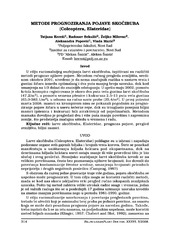Приказ основних података о документу
Methods for predicting wireworm occurrence (Coleoptera, Elateridae)
Metodi prognoziranja pojave skočibuba (Coleoptera, Elateridae)
| dc.creator | Kereši, Tatjana | |
| dc.creator | Sekulić, Radosav | |
| dc.creator | Milovac, Željko | |
| dc.creator | Popović, Aleksandra | |
| dc.creator | Marić, Vlada | |
| dc.date.accessioned | 2021-04-26T18:25:27Z | |
| dc.date.available | 2021-04-26T18:25:27Z | |
| dc.date.issued | 2008 | |
| dc.identifier.issn | 0354-6160 | |
| dc.identifier.uri | http://fiver.ifvcns.rs/handle/123456789/620 | |
| dc.description.abstract | With the aim of more rationally wireworm control, different methods for their forecast were investigated. By standard, manual soil survey (0.25 m2), in the middle of October 2001, it was established that there were no significant differences in Elaterid species structure and population densities between optimal and two times smaller number of samples, while on three times smaller number they are. During April-May 2002, potato baits attracted two times more (47.2/m2) and a wheat and corn seed baits even 2.5-15 times more (63-382/m2) wireworms than it was found in standard soil samples (25.4/m2). In early March 2008, potato as attractant was not successful in forecasting wireworms in sugar beet, while wheat and corn seeds were more efficient sown like triangle than single. By plant baits it is sufficiently to survey two or more times less area and four or more times less volume of soil, respectively, which is significant saving in time and labor. | en |
| dc.description.abstract | cilju racionalnijeg suzbijanja larvi skočibuba, ispitivani su različiti metodi prognoze njihove pojave. Metodom ručnog pregleda zemljišta, sredinom oktobra 2001, utvrđeno je da nema značajnih razlika u sastavu vrsta i gustini žičara između optimalnog i dva puta manjeg broja uzoraka, dok kod smanjenja na 1/3 dolazi do znatnijih odstupanja. U aprilu-maju 2002, pomoću krtola krompira registrovana je skoro dva puta veća gustina larvi skočibuba (47,2/m2), a pomoću semena pšenice i kukuruza 2,5-15 puta veća gustina (63,0-382,1/m2), u odnosu na ručno uzete probe (25,4/m2). U prvoj polovini marta 2008, mamci sa krompirom nisu se pokazali pogodnim za prognoziranje pojave žičara u usevu šećerne repe, dok su trouglasto posejani biljni mamci (pšenica i kukuruz) bili atraktivniji od pojedinačnih. Metodom mamaca dovoljno je pregledati dva i više puta manju površinu i zapreminu zemlje, što predstavlja značajnu uštedu u vremenu i radu. | sr |
| dc.publisher | Univerzitet u Novom Sadu - Poljoprivredni fakultet - Departman za zaštitu bilja i životne sredine "dr Pavla Vukasovića", Novi Sad | |
| dc.rights | openAccess | |
| dc.source | Biljni lekar | |
| dc.subject | wireworms | en |
| dc.subject | Elateridae | en |
| dc.subject | forecasting | en |
| dc.subject | soil survey | en |
| dc.subject | plant baits | en |
| dc.subject | larve skočibuba | sr |
| dc.subject | Elateridae | sr |
| dc.subject | prognoza pojave | sr |
| dc.subject | pregled zemljišta | sr |
| dc.subject | biljni mamci | sr |
| dc.title | Methods for predicting wireworm occurrence (Coleoptera, Elateridae) | en |
| dc.title | Metodi prognoziranja pojave skočibuba (Coleoptera, Elateridae) | sr |
| dc.type | article | |
| dc.rights.license | ARR | |
| dc.citation.epage | 320 | |
| dc.citation.issue | 5 | |
| dc.citation.other | 36(5): 314-320 | |
| dc.citation.spage | 314 | |
| dc.citation.volume | 36 | |
| dc.identifier.fulltext | http://fiver.ifvcns.rs/bitstream/id/1477/617.pdf | |
| dc.identifier.rcub | https://hdl.handle.net/21.15107/rcub_fiver_620 | |
| dc.type.version | publishedVersion |


